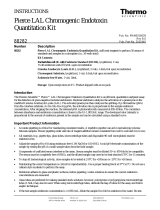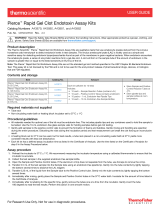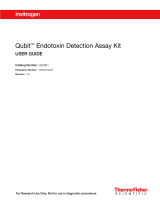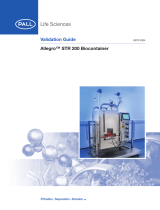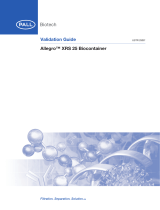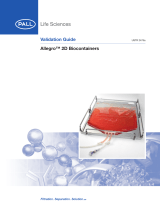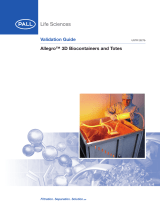Page is loading ...

Pierce™ Chromogenic Endotoxin Quant Kit
Catalog NumbersA39552S, A39552, and A39553
Doc. Part No. 2162713 Pub.No. MAN0017902 Rev. B.0
WARNING! Read the Safety Data Sheets (SDSs) and follow the handling instructions. Wear appropriate protective eyewear, clothing, and
gloves. Safety Data Sheets (SDSs) are available from thermofisher.com/support.
Contents
Product Cat. No. Contents Storage
Pierce™ Chromogenic
Endotoxin Quant Kit
A39552S
Kit sucient for 30 tests of standards and samples in a microplate
Contents:
Lyophilized E. coli (0111:B4) Endotoxin Standard, 1 vial, 10-50 endotoxin units (EU)/vial
Lyophilized Amebocyte Lysate, 1 vial, 1.7 mL/vial upon reconstitution
Lyophilized Chromogenic Substrate, 1 vial, 3.4 mL/vial upon reconstitution
Endotoxin-Free Water, 1 vial, 50 mL
Store at 4°C.
A39552
Kit sucient for 60 tests of standards and samples in a microplate
Contents:
Lyophilized E. coli (0111:B4) Endotoxin Standard, 2 vials, 10-50 endotoxin units
(EU)/vial
Lyophilized Amebocyte Lysate, 2 vials, 1.7 mL/vial upon reconstitution
Lyophilized Chromogenic Substrate, 2 vials, 3.4 mL/vial upon reconstitution
Endotoxin-Free Water, 2 vials, 50 mL/vial
A39553
Kit sucient for 240 tests of standards and samples in a microplate
Contents:
LyophilizedE. coli (0111:B4) Endotoxin Standard, 8 vials, 10-50 endotoxin units
(EU)/vial
Lyophilized Amebocyte Lysate, 8 vials, 1.7 mL/vial upon reconstitution
Lyophilized Chromogenic Substrate, 8 vials, 3.4 mL/vial upon reconstitution
Endotoxin-Free Water, 4 vials, 50 mL/vial
Product description
The Thermo Scientific™ Pierce™ Chromogenic Endotoxin Quant Kit is an ecient, quantitative endpoint assay that uses amebocyte lysates derived
from blood of the horseshoe crab to quantitate endotoxin in protein, peptides, antibodies or nucleic acid samples. Amebocyte lysates are widely
used as a simple and sensitive assay for the detection of endotoxin lipopolysaccharide (LPS), the membrane component of gram-negative
bacteria. When endotoxin encounters the amebocyte lysate, a series of enzymatic reactions results in the activation of Factor C, Factor B and
pro-clotting enzyme. The activated enzyme catalyzes the release of p-nitroaniline (pNA) from the colorless chromogenic substrate, Ac-Ile-Glu-Ala-
Arg-pNA, producing a yellow color. After stopping the reaction, the released pNA is photometrically measured at 405 nm. The correlation between
absorbance and endotoxin concentration is linear in the 0.1-1.0 EU/mL and in 0.01-0.1 EU/mL range. The developed color intensity is proportional
to the amount of endotoxin present in the sample and can be calculated using a standard curve.
Important product information
Note: Thorough cleanliness in labware, raw materials, and in lab technique is required to accurately detect levels of endotoxin in a given sample.
• Accurate pipetting is critical for maintaining consistent results. A repetitive pipettor can aid in normalizing volumes between samples. Ensure
pipetting order and rate of reagent addition remain consistent from well-to-well and row-to-row.
• All materials (e.g., pipette tips, glass tubes, microcentrifuge tubes and disposable 96-well microplates) must be endotoxin-free.
• Maintaining the correct temperature is critical for reproducibility. Use a proper heating block at 37±1°C. Cabinet-style incubators are not
recommended to perform the assay.
• Endotoxin adheres to glass and plastic surfaces; before pipetting, vortex solutions to ensure the correct endotoxin concentrations are
measured.
• Glass tubes are recommended for making standard stock solutions.
• Each lysate lot is tested for functionality using the United States Reference Standard EC-6. The assay lot is then matched to a lot of our
Endotoxin Standard (ES) by testing in parallel with the Reference Standard Endotoxin (RSE). The RSE/ES correlation assay determines the
potency of each ES lot when used with each matching lysate lot.
USER GUIDE
For Research Use Only. Not for use in diagnostic procedures.

Materials required but not supplied
• Disposable endotoxin-free glass tubes or pyrogen-free 1.5 mL microcentrifuge tubes
• Disposable endotoxin-free pipette tips
• Disposable endotoxin-free 96-well microplates or plate strips
• Stable temperature plate heater (37±1°C)
• Pipettor
• Repetitive pipettor (optional) or multichannel pipettor
• Pyrogen-free reservoir
• Microplate reader
• 25% acetic acid (stop solution)
Prepare materials
Note: Equilibrate all reagents to room temperature before use.
Prepare Endotoxin Standard Stock Solutions
1. Each E. coli Endotoxin Standard vial contains 10-50 EU of lyophilized endotoxin; the actual potency is printed on the label. Reconstitute with
room temperature Endotoxin-Free Water by adding 1/10 mL of the EU amount indicated on the vial to make Endotoxin Standard (ES) Solution
at 10 EU/mL (e.g., a vial with potency of 15 EU, when reconstituted with 1.5 mL of Endotoxin-Free Water (EFW), will yield a concentration of
10 EU/mL).
2. Vortex the solution vigorously for 15 minutes (recommended <1500 rpm).
Note: Reconstituted stock solution is stable for 4 weeks at 2-8°C. Prior to subsequent use, warm the solution to room temperature and
vigorously mix for 15 minutes. This is important because the endotoxin adheres to the sides of the glass vial.
3. Prepare High Standards (0.1-1.0 EU/mL) (Table 1) or Low Standards (0.01-0.1 EU/mL) (Table 2) from the Endotoxin Standard Solution (10
EU/mL) using the dilutions and procedures in Tables 1 and 2.
Table1High Standards (0.1-1.0 EU/mL)
Vial
Volume of Endotoxin
Standard Solution
(mL)
Volume of Standard 1
(mL)
Endotoxin-Free Water
(mL)
Final Endotoxin Concentration
(EU/mL)
Vortex Time
(min)
Standard 1 0.20 — 1.80 1.00 2
Standard 2 — 1.00 1.00 0.50 1
Standard 3 — 0.50 1.50 0.25 1
Standard 4 — 0.20 1.80 0.10 1
Blank — — 0.50 0 —
Table2Low Standards (0.01-0.1 EU/mL)
Vial
Volume of
Endotoxin
Standard Solution
(mL)
Volume of Stock
(mL)
Volume of Standard
1
(mL)
Endotoxin-Free Water
(mL)
Final Endotoxin
Concentration
(EU/mL)
Vortex Time
(min)
Stock 0.20 — — 1.80 1.00 2
Standard 1 — 0.20 — 1.80 0.100 2
Standard 2 — — 1.00 1.00 0.050 1
Standard 3 — — 0.50 1.50 0.025 1
Standard 4 — — 0.20 1.80 0.010 1
Blank — — — 0.50 0 —
Reconstitute Lyophilized Amebocyte Lysate
1. Reconstitute Lyophilized Amebocyte Lysate immediately before use with 1.7 mL of Endotoxin-Free Water (EFW) and swirl gently to
dissolve the powder. If more than 1 vial is required, pool 2 or more vials before use. Avoid foaming; do not vortex the solution.
Note: Make sure to recover all of the powder from the sides and the cap of the vial by gently inverting end-over-end. Extreme care must be
taken not to touch the inside part of the cap to avoid contamination.
Note: Reconstituted amebocyte lysate solution is stable for 1 week at -20°C or colder if frozen immediately after reconstitution. Upon
thawing, the reconstituted lysate solution may be used only 1 time. Once thawed, gently swirl the reagent to mix before use.
2Pierce™ Chromogenic Endotoxin Quant Kit User Guide

Sample preparation
• Adjust the sample pH to 6-8 using endotoxin-free 0.1M NaOH or 0.1M HCl. Avoid pH-electrode contamination of the sample by testing the pH
of a small sample taken from the bulk sample.
• Components of undiluted serum interfere in the assay. Serum samples must be diluted 50- to 100-fold to be compatible. The serum must be
completely free of red blood cells, and the diluted sample may need to be heat-shocked (70°C for 15 minutes).
• To stop all bacteriological activity in test samples, store samples to be tested at 2-8°C for <24 hours or -20°C for >24 hours.
Chromogenic Substrate
Each vial contains 3.4 mg of lyophilized Chromogenic Substrate. Reconstitute the substrate by adding 3.4 mL of Endotoxin-Free Water.
Note: Reconstituted Chromogenic Substrate is stable for 4 weeks when stored at 2-8°C. Pre-warm a sucient substrate amount for the assay
to 37°C for no more than 5-10 minutes prior to use.
Assay procedure
Note: Equilibrate all reagents to room temperature before use. Ensure pipetting order and rate of reagent addition remain consistent from
well-to-well and row-to-row throughout the procedure.
1. Prepare all reagents and standards as directed in previous section immediately before use.
2. Pre-equilibrate plate in a heating block at 37±1°C. Throughout the assay procedure, maintain the plate at 37±1°C.
3. Add 50 µL of Endotoxin Standard dilutions, blank, and samples per well.
Note: It is recommended to run each sample and standards in triplicate, including triplicate of a blank (50 µL of Endotoxin-Free Water).
4. Keeping the plate at 37±1°C, add 50 µL of the reconstituted Amebocyte Lysate Reagent per well. Begin timing as the lysate is added to the
first well.
5. Once the Amebocyte Lysate Reagent has been added to the plate wells, briefly remove from the plate heater and mix by gently tapping 10
times on the side of the plate, avoiding spilling. Return the plate to the plate heater and incubate at 37±1°C for the time T1 indicated on the
lysate vial.
Note: T1 High = Time 1 for High Standards and T1 Low = Time 1 for Low Standards.
6. Reconstitute the Chromogenic Substrate as described in Material Preparation with 3.4 mL of Endotoxin-Free Water. Mix gently by tilting and
swirling the vial. Pre-warm to 37±1°C for 5 minutes before use.
7. After exactly time T1, add 100 µL per well of pre-warmed reconstituted Chromogenic Substrate Solution.
8. Once the substrate solution has been added into all plate wells, briefly remove from the plate heater and mix gently by tapping 10 times to
facilitate mixing. Return to the plate heater at 37±1°C for T2 = 6 minutes.
9. At exactly T2 = 6 minutes, add 50 µL per well of Stop Solution (25% acetic acid).
10. Once the stop solution has been added to the plate wells, remove the plate from the plate heater and mix by gently tapping 10 times on the
side of the plate.
11. Read the optical density (OD) at 405 nm immediately after assay completion. If the plate is read at a later time, keep covered to avoid
evaporation.
12. Subtract the average absorbance of the blank replicates from the average absorbance of all individual standards and sample replicates to
calculate mean ∆ absorbance.
13. Prepare a standard curve by plotting the average blank-corrected absorbance for each standard on the y-axis vs. the corresponding
endotoxin concentration in EU/mL on the x-axis. The coecient of determination, r2, must be ≥0.98.
Note: Do not include the blank OD in the calculation of the regression line.
14. Use the formulated standard curve (linear regression) to determine the endotoxin concentration of each sample.
Table3Example data and standard curve for Low Standard.
UE/mL Avg. OD (405 nm) Δ Std. Dev. %CV
0.1 0.5120 0.3937 0.0137 3
0.05 0.3129 0.1945 0.0015 1
0.025 0.1851 0.0668 0.0001 0
0.01 0.1353 0.0170 0.0003 2
0 0.1183 0 0.0024 —
Pierce™ Chromogenic Endotoxin Quant Kit User Guide 3

Table4Example data and standard curve for High Standard.
UE/mL Avg. OD (405 nm) Δ Std. Dev. %CV
1.0 1.4327 1.3162 0.0774 6
0.5 0.7382 0.6217 0.0158 3
0.25 0.3388 0.2223 0.0045 2
0.1 0.1581 0.0416 0.0018 4
0 0.1165 0 0.0033 —
Troubleshooting
Observation Possible cause Recommended action
Non-linear standard curve. Endotoxin Standard Solution and
dilutions were not mixed well.
Vortex the Endotoxin Standard Solution for 15 minutes before each use.
Vortex all endotoxin standard dilutions for 1-2 minutes before each use.
Vortex the endotoxin standard dilutions for 2 minutes if they were sitting for
>10 minutes after preparation before adding into the plate wells.
Pipetting order and rate of reagent
addition were irregular.
Ensure pipetting order and rate of reagent addition remain consistent from
well-to-well and row-to-row.
Use a repetitive or multichannel pipettor.
Incubation times were not followed. Strictly adhere to the incubation times.
Start the timer at the point of adding reagent into the first well.
Higher absorbance in blank than
standard dilutions.
Materials (e.g., tips, vials, microplates)
were contaminated.
Use endotoxin-free materials.
Higher absorbance in samples than
standard curve.
Test sample endotoxin concentration is
>1.0 EU/mL (for High Standard curve)
or >0.1 EU/mL (for Low Standard
curve).
Dilute the sample 5-fold in Endotoxin-Free Water. Re-test.
Samples turning yellow immediately
after addition of the Stop Solution
(25% acetic acid).
Samples contain substances that
turns yellow in acidic environments
(e.g., certain tissue culture media).
To determine if a sample's intrinsic color will alter the absorbance
readings, construct a mock reaction tube by adding 50µL of sample,
150 µL of Endotoxin-Free Water and 50 µL of Stop Solution with no
incubation. Read the absorbance at 405 nm. If the absorbance is
significantly greater than the absorbance of Endotoxin-Free water, then the
intrinsic color will alter the correct sample absorbance readings. In such
cases, include appropriate controls in the assay.
Interfering substances
• The presence of interfering substances in test samples can cause product inhibition leading to false negatives. If unsure if your sample
contains interfering substances, it is recommended to determine the potential product inhibition for each sample type undiluted or at an
appropriate dilution (e.g., serum).
• To verify potential product inhibition, add a known amount of endotoxin to an aliquot or dilution of your test sample (e.g., 0.5 EU/mL). Assay
the spiked sample and an unspiked sample to determine the respective endotoxin concentrations. The dierence between the two calculated
endotoxin values should equal the known concentration of the spike ±25%. See example below.
• Samples showing inhibition on the amebocyte lysate reaction may require further dilution to overcome the inhibitory eects. Once the
non-inhibitory dilution is determined, the exact dilution can be found by testing two-fold dilutions near that dilution. The degree of inhibition or
enhancement is dependent on the product concentration.
Table5Example with sample containing 20% glycerol.
Sample Dilution Observed Spiked[1] Sample Concentration
(EU/mL)
Observed Unspiked Sample
Concentration
(EU/mL)
Δ
Undiluted 0.103 0.099 0.004 Inhibitory
1:20 0.649 0.102 0.547 Non-inhibitory
[1] Spiked concentration should show a value of 0.50 EU/mL. The value of 0.103 is indicative of inhibition for sample containing 20% glycerol.
4Pierce™ Chromogenic Endotoxin Quant Kit User Guide

Workflow
1. Pre-equilibrate the plate to 37±1°C for 10 minutes.
EFW ES
2. Reconstitute Endotoxin Standard (ES) to 10 EU/mL with Endotoxin-Free Water (EFW).
3. Mix vigorously for 15 minutes.
EFW
ES
0.2 mL
1.8 mL 1.0 EU/mL
10 EU/mL
4. Prepare 1.0 EU/mL Stock from 10 EU/mL Endotoxin Standard Solution.
5. Vortex for 2 minutes.
1.0 mL 0.5 mL 0.2 mL
1.0 mL 1.5 mL 1.8 mL 0.5 mL
EFW
1.0 EU/mL 0.5 EU/mL 0.25 EU/mL 0.1 EU/mL EFW
6. Using 1.0 EU/mL Stock, prepare a series of endotoxin dilutions.
7. Vortex for 1 minute.
8. Prepare samples according to information in the user guide.
1.7 mL
EFW Lysate
9. Reconstitute the Amebocyte Lysate with 1.7 mL EFW.
10. Gently swirl and avoid foaming. Lysate reagent must be used within 5 minutes.
1.0 EU/mL 0.5 EU/mL 0.25 EU/mL 0.1 EU/mL EFW
11. Keeping the plate at 37±1°C, add 50 µL of each endotoxin dilution, sample, and blank to the plate
wells (triplicates).
Lysate 37°C
12. Keeping the plate at 37±1°C, add 50 µL of Amebocyte Lysate Reagent to the wells following the
same order of addition as the endotoxin dilution and samples.
13. Mix well by gently tapping on the side of the plate.
14. Cover and incubate for time T1 (High or Low) as indicated on the Lysate label.
3.4 mL
EFW SUB
15. Reconstitute Chromogenic Substrate (SUB) with 3.4 mL of EFW.
16. Pre-warm the solution for 5 minutes at 37±1°C.
SUB
37°C
17. Keeping the plate at 37±1°C, add 100 µL of Chromogenic Substrate Solution to each well following
the same order of addition as previous steps.
18. Mix well by gently tapping on the side of the plate.
19. Incubate for 6 minutes at 37±1°C.
25%
acetic acid
20. Add 50 µL of 25% acetic acid to each well to stop the reaction.
21. Mix well by gently tapping on the side of the plate.
22. Read the absorbance at 405 nm.
Pierce™ Chromogenic Endotoxin Quant Kit User Guide 5

Related products
Product Cat. no.
Pierce™ High Capacity Endotoxin Removal Resin, 10 mL 88270
Pierce™ High Capacity Endotoxin Removal Resin, 100 mL 88271
Pierce™ High Capacity Endotoxin Removal Resin, 250 mL 88272
Pierce™ High Capacity Endotoxin Removal Spin Columns, 0.25 mL 88273
Pierce™ High Capacity Endotoxin Removal Spin Columns, 0.50 mL 88274
Pierce™ High Capacity Endotoxin Removal Spin Columns, 1 mL 88276
Detoxi-Gel™ Endotoxin Removing Gel 20339
Detoxi-Gel™ Endotoxin Removing Columns 20344
Pierce™ Rapid Gold BCA Protein Assay Kit A53225
Cole-Parmer™ Two-Position Chilling Heating Block 100 VAC NC1107062
1Roslansky, P.F. and Novitsky, T.J. (1991). Sensitivity of Limulus amebocyte lysate (LAL) to LAL-reactive glucans. J Clin Microbiol 54 (5).
Jcm.asm.org/content/29/11/2477.short
Limited product warranty
Life Technologies Corporation and/or its aliate(s) warrant their products as set forth in the Life Technologies' General Terms and Conditions of
Sale at www.thermofisher.com/us/en/home/global/terms-and-conditions.html. If you have any questions, please contact Life Technologies at
www.thermofisher.com/support.
Thermo Fisher Scientific | 3747 N. Meridian Road | Rockford, Illinois 61101 USA
For descriptions of symbols on product labels or product documents, go to thermofisher.com/symbols-definition.
Revision history:Pub.No. MAN0017902
Revision Date Description
B.0 18 January 2023 The related products list was updated.
A.0 7 September 2018 New document for Pierce3 Chromogenic Endotoxin Quant Kit UG.
The information in this guide is subject to change without notice.
DISCLAIMER: TO THE EXTENT ALLOWED BY LAW, THERMO FISHER SCIENTIFIC INC. AND/OR ITS AFFILIATE(S) WILL NOT BE LIABLE FOR SPECIAL, INCIDENTAL, INDIRECT,
PUNITIVE, MULTIPLE, OR CONSEQUENTIAL DAMAGES IN CONNECTION WITH OR ARISING FROM THIS DOCUMENT, INCLUDING YOUR USE OF IT.
Important Licensing Information: These products may be covered by one or more Limited Use Label Licenses. By use of these products, you accept the terms and conditions of all
applicable Limited Use Label Licenses.
©2023 Thermo Fisher Scientific Inc. All rights reserved. All trademarks are the property of Thermo Fisher Scientific and its subsidiaries unless otherwise specified.
thermofisher.com/support|thermofisher.com/askaquestion
thermofisher.com
18 January 2023
/
